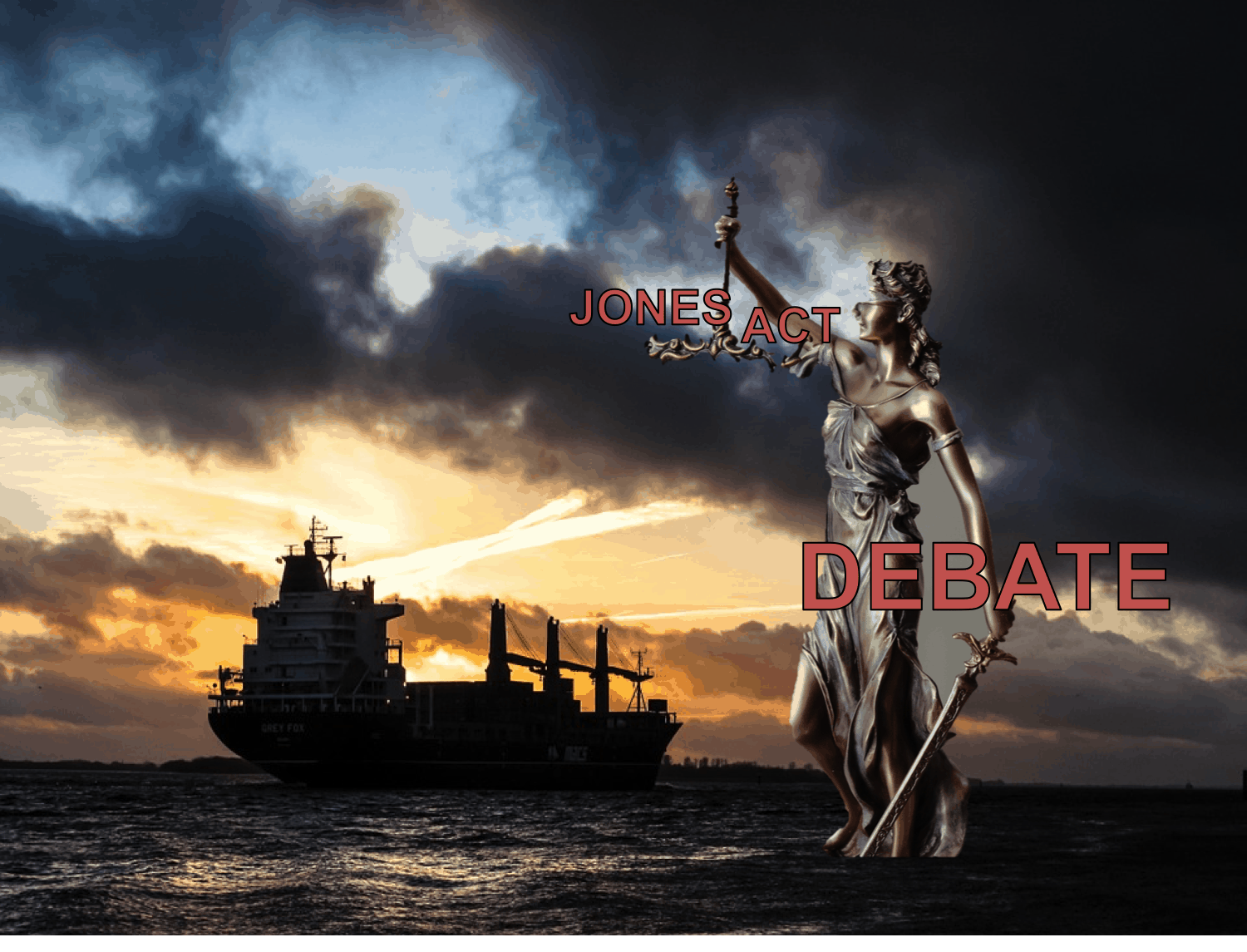The Jones Act Debate Part 3: Cost to Hawaii
Does the Jones Act have a negative impact on the economies of noncontiguous U.S. states and territories? We’ll look at arguments concerning just that, with an eye specifically on Hawaii, in today’s post as we continue our series on the Jones Act.
Here’s what we’ve covered so far:
President Biden Supports the Jones Act – What Is It and What Does It Do?
The Jones Act Debate Part 1: National Security
The Jones Act Debate Part 2: Protectionism or Hindrance
Again, I’ll take a moment to reiterate that the point of this series is not to take sides on whether the Jones Act should be repealed, reformed, or protected. Instead, this series shares arguments for and against the Jones Act, so you can learn more about it, know the key issues to research in regard to it if you want to know more, and decide for yourself where you stand on the legislation.
With that, let’s get into the debate…
Opponents of the Jones Act Say It Hurts Noncontiguous U.S. States & Territories Like Hawaii

On December 20th, 2019, Congressman Ed Case from District 1 of Hawaii stepped onto the House floor to introduce three bills that would reform the Merchant Marine Act of 1920, commonly known as the Jones Act.
He argued the Jones Act creates a monopolistic closed market on domestic cargo shipping to noncontiguous U.S. states and territories, especially island ones as is the case with Hawaii and Puerto Rico; it dramatically increases the shipping cost and, therefore, the cost of goods and living in these places; and stifles the export economies of these places as well.
Here are some excerpts from Congressman Case’s speech:
The Jones Act was enacted in a protectionist era under the guise of preserving a strong national merchant marine. But today it is just an anachronism: most of the world’s shipping is by way of an international merchant marine functioning in an open, competitive market. And those few U.S. flag cargo lines that remain have maneuvered the Jones Act to develop virtual monopolies over domestic cargo shipping to, from and within our most isolated and exposed locales – our island and offshore states and territories – that have no alternative modes of transportation such as trucking or rail.
My Hawai‘i is a classic example. Located almost 2,500 miles off the West Coast, we import well over 90 percent of our life necessities by ocean cargo. There are plenty of international cargo lines who could and would compete for a share of that market. Yet only two U.S. flag domestic cargo lines—Matson Navigation and Pasha Hawai‘i—operate a virtual duopoly over our lifeline.
While they are nominally subject to federal regulation, the fact of the matter is that cargo prices have gone in only one direction–up, fast and repeatedly, despite a surplus of international shipping–and it is indisputable that there is no downward market pressure which would otherwise result from meaningful competition. These accelerating cargo prices are not absorbed by the shipping lines, but passed through all the way down the chain, to the transporters, wholesalers, retailers, small businesses, mom-n-pops and ultimately consumers, of all of the elementals of life, from food to medical supplies, clothes, housing and virtually all other goods. The result is a crippling drag on an already-challenged economy and the very quality of life in Hawai‘i.
The broadest, deepest effects of the Jones Act on Hawai‘i result from its impact on westbound imports from the continental United States to Hawai‘i. But Hawai‘i is an export location as well, in key products such as agriculture and livestock. Here the Jones Act also effectively stifles meaningful competition in getting those products to their primary markets on the U.S. Mainland. Because the producers of these products and all that rely for their own livelihood on their successful export have to eat inflated shipping costs, these export industries, which any economist knows are the ultimate key to any economy’s prosperity, are also crippled.
Congressman Case gets into specifics as to how the Jones Act hurts Hawaii’s cattle industry, seriously hurting Hawaii’s ranchers in bringing cattle to the U.S. mainland market. Then he moves to some specific cost of goods/living numbers being higher because of shipping costs:
At a basic level, the everyday goods that we rely on in Hawai‘i cost much more than on the Mainland, a difference which largely cannot be attributed to anything other than shipping costs. Yesterday, there was a 30 percent difference in the price of a gallon of milk at Safeway grocery stores in Honolulu and Long Beach, California. My constituents pay $6.39 for a gallon of whole milk and those in Long Beach, one of the major ports where Hawai‘i’s good come from, pay $4.49.
Supporters of the Jones Act would likely say that it will of course cost more to buy goods that have to be shipped over the ocean, but Congressman Case uses shipping cost comparisons between Puerto Rico, which falls under the Jones Act, and nearby non-U.S. territories, which don’t fall under the act, to show the legislation inflates shipping costs, and therefore the price of goods:
In 2012, the Federal Reserve Bank of New York studied Puerto Rico’s economy and found that “the high cost of shipping is a substantial burden on the Island’s productivity.” The New York Fed found that, “[i]t costs an estimated $3,063 to ship a twenty-foot container of household and commercial goods from the East Coast of the United States to Puerto Rico; the same shipment costs $1,504 to nearby Santo Domingo (Dominican Republic) and $1,687 to Kingston (Jamaica)—destinations that are not subject to Jones Act restrictions.” There is only one reason why costs are double to ship from the continental United States to a domestic port in Puerto Rico as compared to foreign ports in the Dominican Republic and Jamaica: there is international competition on the latter routes, none on the domestic route and the shipping companies take full advantage of that lack of competition.
Proponents of Jones Act Say It Does Not Increase the Cost of Living in Hawaii and Shipping Competition There Is Healthy
An obvious issue with the last argument made by Congressman Case is it is using data that is now almost a decade old. The milk price he points to, however, was current when he was speaking in 2019. Proponents of the Jones Act will point to a study even more recent than those milk costs that concludes the Jones Act does not raise the cost of living in Hawaii.
The study was released in July of 2020. American Maritime published an article about the study that opens exactly how proponents of the Jones Act would want it to:
Economists from Boston based Reeve & Associates (Reeve) and Hawaii based TZ Economics have released a joint report, “The Impact of the Jones Act on Hawaii,” that concluded the Jones Act has no significant impact on the cost of living in Hawaii. In addition, the report found that freight rates in the U.S. Mainland-Hawaii trade lane have declined in real terms over the last ten years, while the Jones Act has delivered positive and substantial economic contributions, including job creation, new infrastructure investments, and a reliable pipeline for critical consumer and industrial goods moving to and from the Islands.
Here’s evidence cited from the study in the article regarding cost of goods/living in Hawaii:
• A market basket study of 200 consumer goods purchased from major retailers such as Costco, Home Depot, Target and Walmart found no significant difference in the price of consumer goods. 142 out of 200 items (71%) were precisely the same in stores in Hawaii as they were in California. In some cases, retail prices of goods were cheaper in Hawaii.
• The study found that while Hawaii does have a high cost of living, that cost is primarily driven by housing expenses and other factors, not the type of consumer goods carried to Hawaii by Jones Act carriers.
While Congressman Case argued shipping costs between mainland U.S. and Hawaii have done nothing but increase with the lack of competition from foreign shipping, the study’s findings say these freight rates have actually decreased (the subtitle of American Maritime article is even Ocean Freight Rates Declined Since 2008):
• The study shows that freight rates in the Mainland-Hawaii trade have declined in real terms when considering the cost of inflation, while benchmarks such as overall U.S. inflation and intercity truckload prices have increased substantially (28%). This freight rate decline is despite a 50% increase in wharfage charges for port/terminal improvements.
According to the creators of the study, this decrease in rates is due to healthy competition between U.S. flagged carriers that deliver goods to and from Hawaii. Rather than the duopoly Congressman Case describes between Matson Navigation and Pasha Hawaii, the study points to three U.S. flagged carriers – the two previously mentioned plus Aloha Marine Lines – “dedicated to Hawaii’s specific needs for high frequency and fast transit to deliver consumer goods to the Hawaiian Islands”:
• Three U.S. flagged carriers with a fleet of twenty combined vessels, specifically designed to accommodate the needs of Hawaii transportation commerce, currently provide regular scheduled shipping services between the U.S. Mainland and Hawaii.
• Due to intense and healthy competition, freight rates have declined in real terms while carriers have increased capacity with modern, custom-designed vessels.
• Jones Act carriers have introduced five new U.S. vessels, as well as three more on the way in the fourth quarter of 2020. According to the study, with these most recent additions, there is more than ample capacity to meet the needs of Hawaii families and businesses. In fact, Jones Act carriers have increased capacity by 22% since 2015 with the addition of new vessels. The level of available capacity in the market naturally drives healthy price competition.
The article goes so far as to say “eliminating the Jones Act could undermine priority, frequency, and speed” of shipping to and from Hawaii.
As far as hurting Hawaii’s economy, proponents say it helps Hawaii’s economy and would point to this study as evidence that it supports 13,000 jobs for Hawaiian families:
• The Jones Act delivers $787 million in annual workforce income and $3.3 billion economic impact to the local economy.
The Debate Continues
Congressman Case brought up Puerto Rico, pointing to shipping costs as evidence of the damage the Jones Act does. Proponents of the Jones Act have a response for that too, but Puerto Rico has another big issue debated in regards to it. When we continue examining this debate, we’ll focus our sights on Puerto Rico.



